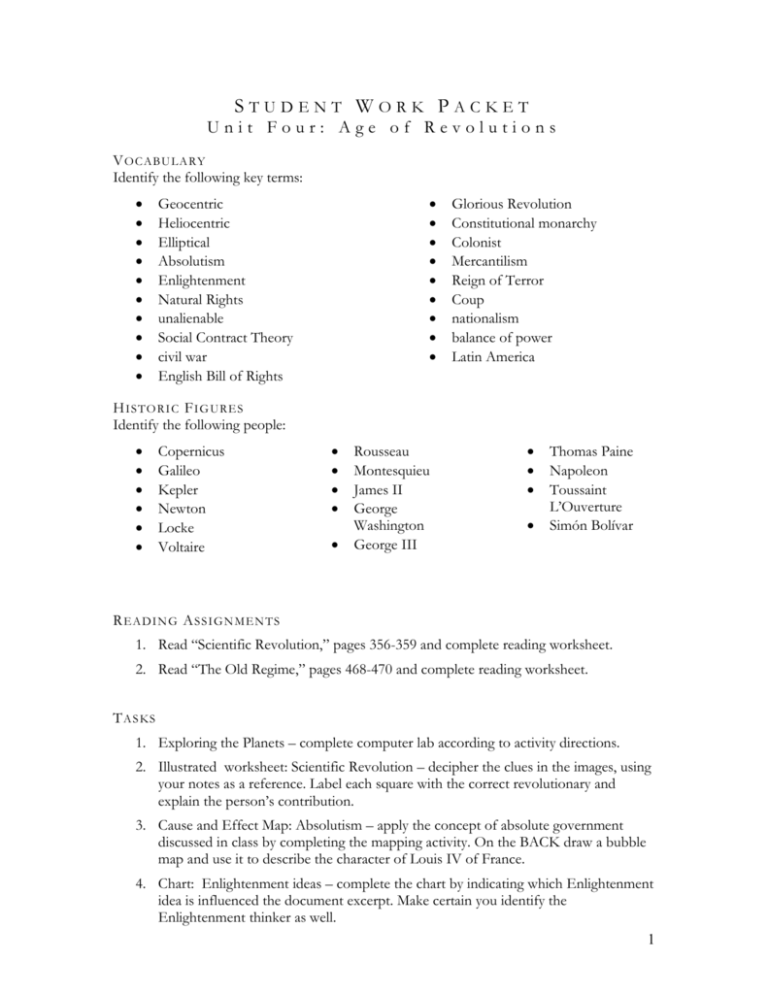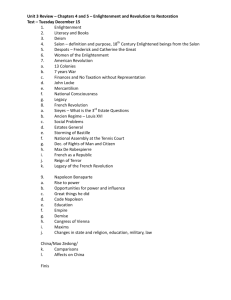student work packet - Bibb County Schools
advertisement

STUDENT WORK PACKET Unit Four: Age of Revolutions V O CA B U LA RY Identify the following key terms: Geocentric Heliocentric Elliptical Absolutism Enlightenment Natural Rights unalienable Social Contract Theory civil war English Bill of Rights Glorious Revolution Constitutional monarchy Colonist Mercantilism Reign of Terror Coup nationalism balance of power Latin America H I S T O RI C F I G U RE S Identify the following people: Copernicus Galileo Kepler Newton Locke Voltaire Rousseau Montesquieu James II George Washington George III Thomas Paine Napoleon Toussaint L’Ouverture Simón Bolívar READING ASSIGNMENTS 1. Read “Scientific Revolution,” pages 356-359 and complete reading worksheet. 2. Read “The Old Regime,” pages 468-470 and complete reading worksheet. T A S KS 1. Exploring the Planets – complete computer lab according to activity directions. 2. Illustrated worksheet: Scientific Revolution – decipher the clues in the images, using your notes as a reference. Label each square with the correct revolutionary and explain the person’s contribution. 3. Cause and Effect Map: Absolutism – apply the concept of absolute government discussed in class by completing the mapping activity. On the BACK draw a bubble map and use it to describe the character of Louis IV of France. 4. Chart: Enlightenment ideas – complete the chart by indicating which Enlightenment idea is influenced the document excerpt. Make certain you identify the Enlightenment thinker as well. 1 5. Cause and Effect Map: English Civil War and Glorious Revolution – map the causes and effects of these events by completing a multi-flow map for each. 6. Case Study: American Revolution – practice your knowledge of the causes of revolution by reading the article describing the American Revolution and completing the exercise at the bottom of the sheet (see article for detailed directions). 7. Case Study: French Revolution – practice your knowledge of the causes of revolution by reading the article describing the French Revolution and completing the exercise at the bottom of the sheet (see article for detailed directions). 8. Mini-project: Causes of Revolution - use the Menu Board and select an activity to complete to demonstrate your understanding of causes of revolution. 9. Comparison activity: Comparing the Revolutions – complete the chart by comparing the revolutions covered in this unit. Use your class notes for a reference, but try to do this one on your own. 10. Map activity – mapping the revolutions L E A RN I N G Q U E S T I O N S 1. What was the scientific revolution about? 2. What is the difference between heliocentric and geocentric? 3. What instrument did Galileo use to prove Copernicus’ theory? 4. What was the main goal of absolute monarchs? 5. Under absolutism, the basis of government power is ______________. 6. Name two Enlightenment thinkers. 7. According to John Locke, the basis of government power is _______. 8. According to John Locke, the purpose of government is __________. 9. What idea did Montesquieu contribute to American government? 10. What are four things that tend to lead (cause) to revolutions? 11. What was the major conflict that led to the English Civil War? 12. What was the MAIN problem that led to the Glorious Revolution in England? 13. Name three documents that limited the power of the English monarchy. 14. What three estates made up the Old Regime in France? 15. What groups of people had to pay most of the taxes? 16. What are two effects of the French Revolution? 17. What mistake did Napoleon make that ultimately led to his fall from power? 18. What was the Congress of Vienna? 19. What influenced the revolutions in Haiti and Latin America? 20. What did the revolution in Haiti begin as? 21. Name one major figure involved in the revolution in Haiti. 22. Name one major figure involved in the Latin American revolutions. 2




